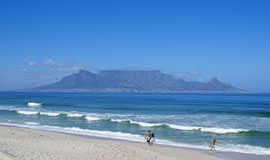
Pretoria – South Africa is known for its scenic beauty, beautiful mountains, magnificent outdoors, friendly people, sunny climate and cultural diversity.
All of these attractions make our country one of the most desired destinations in the world. But the currently economic climate may be forcing many people to travel less because they think it’s expensive.
But there are options. As Nosihle Shelembe discovers, travelling around South Africa doesn’t have to break your bank account.
South Africa offers a variety of holiday destinations which cater for budget travellers as well as those who want to have a luxurious experience. With September known as Tourism Month, some South Africans tend to overlook the beautiful experience of travelling between the country’s nine provinces and what is on offer. But, if figures from South African Tourism are anything to go by, many are embracing the notion of “local is lekker.”
The SA Tourism annual report for Domestic Tourism Performance indicates a total direct domestic spend of more than R23.6 billion in 2015 alone. That is the money travellers spent in different destinations across the country.
Whether you want to spend time at some of the country’s pristine beaches in Plettenberg Bay and Mossel Bay in the Southern Cape, Kwazulu-Natal or Port Alfred in the Wild Coast, it’s all waiting for you. Maybe you just want to visit Table Mountain in Cape Town, or if you prefer the wild side of life, the Kruger National Park has the Big Five which includes buffalo, elephant, leopard, lion as well as rhino. You are spoilt for choice.
Government has identified tourism as a key sector with excellent potential for growth. Authorities aim to increase tourism’s total direct and indirect contribution to the economy from R189, 4 billion (7, 9%) in 2009, to R318, 16 billion in 2015, and R499 billion in 2020.
South African Tourism’s Chief Marketing Officer Margie Whitehouse explains that when South Africans travel their own country, it does not only create jobs but helps drive local businesses as well as local economies.
Domestic tourism also drives entrepreneurship in the sector and encourages the understanding and protection of the country’s heritage and cultural values. Domestic tourism also contributes 52% of total tourism consumption.
“It is also important to note that a healthy domestic tourism culture promotes interest for locals to fall in love with their country and want to explore it in its entirety, especially lesser travelled areas,” says Whitehouse.
She says for the 2015/16 financial year, South African Tourism received a ring fenced amount of R100 million to encourage South Africans to tour their own country.
“The funds were used to create a culture of tourism amongst domestic travellers through affordable deals, and to drive social tourism initiatives in conjunction with the Department of Tourism.”
Here are just some of the things to do without going too deep in your pocket.
You can visit the malaria-free Madikwe Game Reserve in the North West, Marekele National Park in Limpopo, or head out to any of the private lodges or parks in northern KwaZulu-Natal, which is famous for its rhino population.
The Addo Elephant National Park near Port Elizabeth is rated as one of the best places to see the elephants up close and is home to the Big Seven – elephant, rhino, buffalo, lion, leopard, great white sharks and southern right whales. The Addo is one of the few reserves in the world that has all of the Big Seven.
Adventure
Adrenaline junkies are spoilt for choice as the country offers a variety of adventurous activities which include skydiving in Bloemfontein and bungee jumping in Soweto.
Whales, dolphins, sharks, sunfish and seals are just some of the marine wildlife that can be seen in along most routes in the Western Cape.
Wine
The wine-growing areas of Stellenbosch, Paarl, Wellington, Franschhoek, Ceres, Worcester, Bonnievale and Robertson are popular attractions in the Western Cape, where the Mediterranean climate favours the production of superb wines.
For those who want to enjoy the Cape Winelands in a healthy and active way, the Bikes ‘n Wines cycle tours is the best way to visit some of the wine farms.
The cycle tours take place on private farm roads, through the vineyards and tree-lined avenues. Along the way, the groups get to visit some of the best wine farms in the region and to taste the wines.
Other top attractions
On a clear day at the top of the Table Mountain in Cape Town, you should be able to see Robben Island in Table Bay.
Drakensberg Mountains in KwaZulu-Natal offers numerous recreational amenities for fly-fishers, hikers, horse-riders and holidaymakers.
Golfers can also enjoy a beautiful scenery during a game of golf when they visit the Drakensberg Mountains.
The Apartheid Museum in Johannesburg documents South Africa’s struggle for freedom. The museum has over 20 exhibition areas that include film footage, text panels and artefacts.
About an hour’s drive from Johannesburg is the Cradle of Humankind, which is renowned for its extraordinary fossil record of early human ancestors.
A four-hour hot air balloon ride over the malaria-free Pilanesberg Game Reserve offers game viewing at its best. Here, 55 000 ha of trees and grassland supports a wildlife population that includes the Big Five. Close by is Sun City, a popular hotel and leisure centre with a water park and casino. So go out and enjoy - because local is lekker. -SAnews.gov.za


